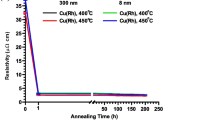Abstract
The Sn-Ag solder was electrodeposited from a bath that basically is composed of tin sulfate (SnSO4), silver nitrate (AgNO3), and thiourea (CH4N2S), acting as a complexing agent to silver. The composition and morphology of electrodeposited Sn-Ag solder were studied in terms of silver concentration in bath current density, duty cycle, and additives. It was possible to control silver content in the electrodeposit by means of varying silver concentration in bath and current density. The microstructure and surface morphology of the electrodeposit become finer and smoother with increasing current density. The pulse-current (PC) plating method was applied to compare to the conventional direct-current (DC) plating. Varying duty cycle in PC plating did not change the microstructure in general, but some improvement in surface roughness was observed compared to DC plating. However, the silver composition in the electrodeposit increased with decreasing the duty cycle at a constant current density. An addition of a surface-active agent helped to reduce the surface roughness and the variation of silver content in the electrodeposit. In an optimum condition, eutectic Sn-Ag solder bumps with a fine pitch of 30 µm and height of 15 µm were successfully electroplated. The composition of Sn-Ag bumps was analyzed by energy dispersive x-ray spectrometry (EDS) and wavelength dispersive x-ray spectrometry (WDS) methods, and the surface morphology was characterized by scanning electron microscopy (SEM) and a three-dimensional surface analyzer.
Similar content being viewed by others
References
European Union, WEEE Directive, 3rd Draft (2000).
Japanese Ministry of Health and Welfare Waste Regulation (1998).
E. Menzel, German patent 718,252 (1942).
H. Leidheiser, Jr. and A.R.P. Ghuman, J. Electrochem. Soc. 120, 60 (1973).
J.C. Puippe and W. Fluehman, Plating Surface Finishing 46 (1983).
S. Arai, Microjoining and Assembly Technology Electronic 3rd Symp., Feb. 6–7 (1997).
T. Kondo et al., Plating Surface Finishing 51 (1998).
S. Arai, T. Watanabe, and M. Higashi, U.S. patent 5,902,472 (11 May 1999).
K. Oshima and S. Yuasa, U.S. patent 5,911,866 (15 June 1999).
S. Arai, U.S. patent 5,948,235 (7 September 1999).
I. Yanada and M. Tsujimoto, U.S. patent 6,099,713 (8 August 2000).
M.P. Toban, D.C. Marcktell, N.D. Brown, and C.A. Doyle, U.S. patent 6,210,556 (3 April 2001).
F.A. Lowenheim, Electroplating (New York: McGraw-Hill Book Co., 1978).
A.C. Tan, Tin and Solder Plating in the Semiconductor Industry (New York: Chapman & Hall, 1993).
S.H. Kim, J.Y. Kim, J. Yu, and T.Y. Lee, J. Electron. Mater. 33, 948 (2004).
I. Ohno, J. Met. Finishing Jpn. 39, 149 (1988).
A. Brenner, Electrodeposition of Alloys, vol. I (New York: Academic Press, 1963).
C.C. Wan et al., Plating 559 (1974).
Author information
Authors and Affiliations
Rights and permissions
About this article
Cite this article
Kim, J.Y., Yu, J., Lee, J.H. et al. The effects of electroplating parameters on the composition and morphology of Sn-Ag solder. J. Electron. Mater. 33, 1459–1464 (2004). https://doi.org/10.1007/s11664-004-0087-9
Received:
Accepted:
Issue Date:
DOI: https://doi.org/10.1007/s11664-004-0087-9




